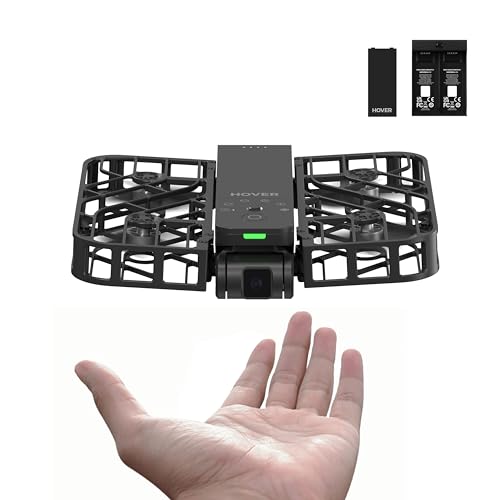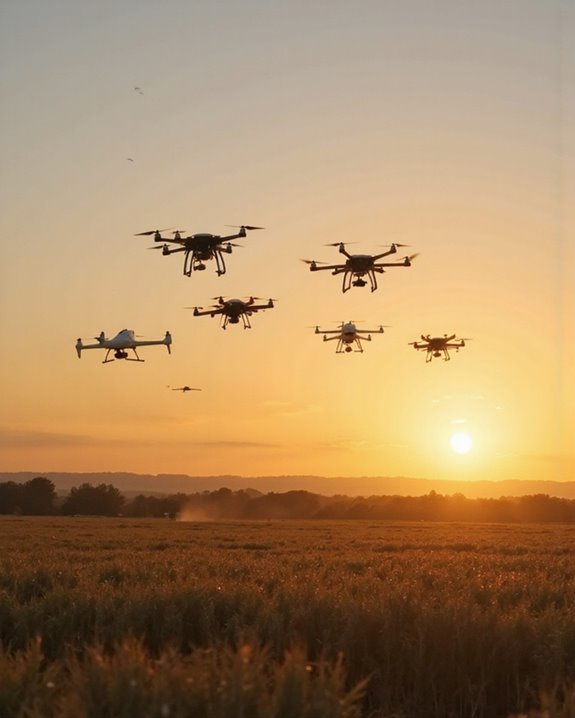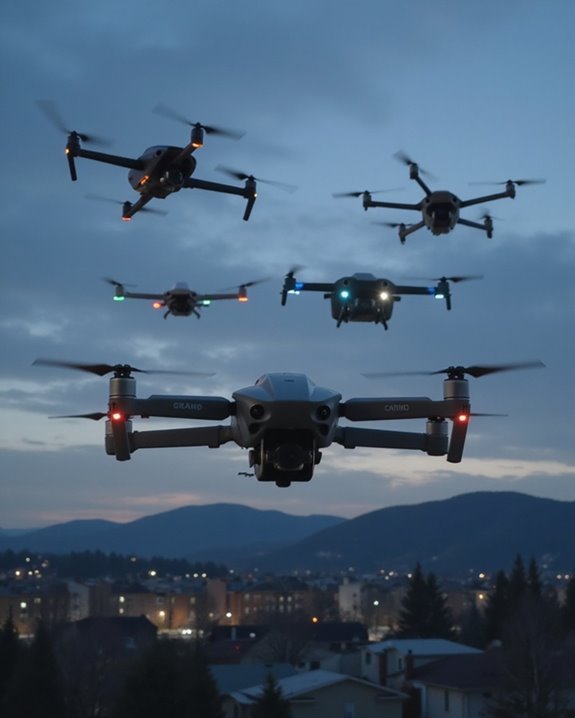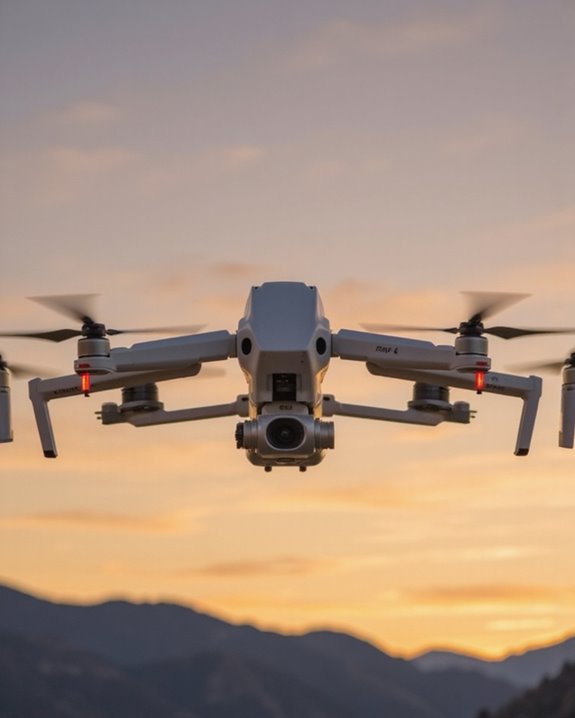The top FLIR drone options combine thermal imaging with impressive flight capabilities! DJI’s Mavic 2 Enterprise Advanced offers industry-leading 640×512 thermal resolution with 30-minute flight time. The Autel EVO II Dual features both 8K visual and 640×512 thermal cameras in a rugged, wind-resistant package. For budget-conscious users, the Parrot Anafi Thermal delivers decent 160×120 thermal imaging with exceptional 78-minute extended flight time using multiple batteries. Each model balances different priorities of image quality, flight stability, and battery life for various thermal imaging needs.
Key Takeaways
- Leading FLIR drones require minimum 640×480 thermal resolution with sensitivity down to 50 mK for optimal detection.
- The best thermal imaging drones combine 4K/6K visual cameras with radiometric measurement capabilities for comprehensive analysis.
- Top models feature 30+ minute flight times per battery, with premium options offering up to 75 minutes using multiple batteries.
- Wind resistance up to L6 classification and GPS-enabled stability systems are essential for reliable thermal imaging operations.
- Superior FLIR drones include intelligent flight features like waypoint navigation, follow-me mode, and auto-return for comprehensive thermal surveys.
X1 Self-Flying Camera Drone with HDR Video Capture
The HOVERAir X1 is a game-changer for content creators who need hands-free aerial photography without the learning curve. This pocket-sized marvel weighs just 1.54 pounds and folds down to a compact 5 x 5.71 x 1.18 inches, making it your perfect on-the-go companion!
You’ll love the intelligent flight paths and follow-me mode that tracks your movement with impressive stability. Simply use palm takeoff, set your parameters, and watch as the X1 captures stunning 2.7K HDR video. No complicated controls here! While some users reported battery issues initially, the company has been quick with replacements. It’s particularly fantastic for weddings, travel, and vertical social media content—though maybe keep it away from lakes!
Best For: Content creators, travelers, and social media enthusiasts who want hassle-free aerial photography without needing drone piloting skills.
Pros:
- Incredibly portable with a pocket-sized, foldable design weighing just 1.54 pounds
- Intelligent flight paths and follow-me mode provide stable, hands-free video capture
- Simple operation with palm takeoff and easy parameter setting, perfect for beginners
Cons:
- Some users have reported battery issues and unexpected crashes
- Limited to 2.7K video resolution, which may not satisfy professional videographers
- Potential reliability concerns near water based on user experiences
Ruko F11PRO 2 Drone with 6K Camera for Adults (70-Min Flight Time)
- 【Soar into Summer Memories】From backyard BBQs to your kid's first bike ride, these are the moments they'll remember. With crisp 6K photos and smooth 4K/30fps video,...
- 【Advanced Image Sensor Lens】F11PRO 2’s premium image sensor lens outshines standard lenses, capturing finer details and richer textures, bringing your world to life...
- 【Stability Redefined】Experience the advantage of our 3-axis brushless gimbal, which provides superior stability and smoothness. With enhanced wind resistance, you can...
Flying photographers seeking extended aerial sessions will find their match in the Ruko F11PRO 2 Drone, a powerhouse that delivers an impressive 70 minutes of flight time with its two included batteries. You’ll capture stunning footage with its 6K camera mounted on a 3-axis brushless gimbal, guaranteeing those sunset shots remain buttery smooth even when the wind picks up.
The drone’s 10,000-foot transmission range gives you plenty of room to explore, while GPS-powered features like follow-me and orbit modes make complex shots a breeze. Even if you’re new to the drone game, the beginner mode and auto-return function guarantee you won’t lose your flying investment to an unexpected gust!
Best For: Photography enthusiasts and drone hobbyists looking for extended flight time, professional-quality aerial footage, and user-friendly GPS features in a mid-range drone package.
Pros:
- Exceptional 70-minute total flight time with two 3200mAh batteries gives users extended shooting sessions without frequent landing
- Premium 6K camera with 3-axis gimbal provides stable, high-resolution footage even in windy conditions
- Advanced GPS features like follow-me, orbit, and waypoint navigation make complex shots accessible for beginners and experienced pilots alike
Cons:
- Actual flight time may average closer to 30 minutes per battery based on user feedback, falling short of the advertised 35 minutes per battery
- At 357g, it’s heavier than some competitor models, potentially affecting agility and portability
- Limited to JPEG image format rather than offering RAW file options that professional photographers might prefer
Bwine F7 GPS Drone with 4K Camera and 3-Axis Gimbal
No products found.
Looking for marathon-worthy flight times? The Bwine F7 soars above competitors with an impressive 75 minutes in the air, thanks to its three 2600mAh batteries! You’ll capture stunning footage through its 4K camera mounted on a 3-axis gimbal that delivers silky-smooth video, even in challenging conditions.
The drone’s intelligence shines with its GPS auto-return features, activating when battery runs low or signal fades. With a control range of 3000m and robust L6 wind resistance, you’re equipped for serious aerial adventures. The night vision capability means your filming doesn’t stop when the sun sets. Plus, with FAA certification already completed, you’re ready for takeoff without regulatory headaches!
Best For: Serious drone enthusiasts and content creators who prioritize extended flight time, stable 4K footage, and advanced flight features without FAA registration hassles.
Pros:
- Exceptional 75-minute flight time with three included batteries gives you extended aerial shooting sessions
- Professional-quality imaging with 4K camera, 3-axis gimbal stabilization, and night vision capabilities
- Comprehensive safety features including GPS auto-return and FAA compliance with remote ID already installed
Cons:
- Long battery charging time of 6-7 hours may require planning ahead for extended use sessions
- Premium features likely come with a higher price point compared to basic drones
- 2000m maximum altitude limitation may restrict certain specialized filming scenarios
Factors to Consider When Choosing a Flir Drone
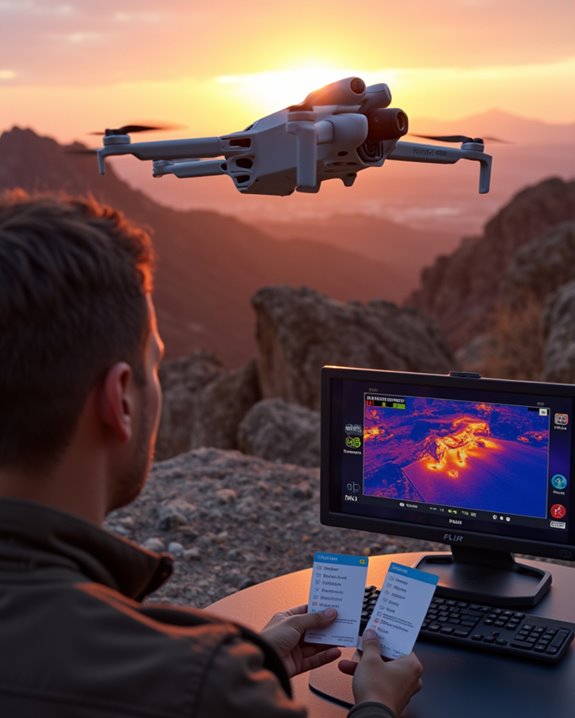
Choosing the right FLIR drone isn’t just about picking the coolest-looking model—you’ll need to evaluate several key factors before making your investment! Consider camera resolution and quality, flight time, range, stability in windy conditions, intelligent flight functions, and portability options to guarantee you’re getting a drone that meets your specific thermal imaging needs. Your perfect thermal drone should balance these essential features while staying within your budget, making your aerial thermal imaging projects both successful and enjoyable.
Camera Resolution and Quality
When it comes to thermal imaging drones, camera resolution and quality aren’t just fancy specs—they’re essential features that determine how effective your aerial thermal detection will be!
Look for thermal cameras with at least 640×480 resolution to make sure you’re capturing sufficient detail in your infrared imagery. Remember, those tiny heat signatures won’t show up if your resolution is too low! You’ll also want to evaluate the visual camera capabilities, where 4K or even 6K resolution will give you crystal-clear footage that pairs perfectly with your thermal data. Don’t overlook sensor size either—larger CMOS sensors deliver better low-light performance, which you’ll appreciate during dawn or dusk missions. And trust me, a drone with 3-axis gimbal stabilization will save you from the headache of jittery footage when the wind picks up!
Flight Time and Range
Great thermal imaging means nothing if your drone drops from the sky after 10 minutes! When selecting a FLIR drone, you’ll want to prioritize models offering flight times of 30+ minutes per charge. Look for batteries rated at 2,600mAh or higher to guarantee you’ll capture all the thermal data you need without constantly landing for battery swaps.
Range matters just as much, especially for industrial inspections or search operations. You’ll want a drone capable of maintaining stable connectivity up to 3,000 meters from your position. Wind resistance (up to level 6 on the Beaufort scale) is your friend here, as it helps maintain stability during breezy conditions while preserving precious battery life. Remember, features like GPS and auto-return aren’t just safety nets—they’re range extenders that’ll bring your investment home safely when signals weaken!
Stability and Wind Resistance
A drone’s ability to remain stable in challenging conditions directly impacts the quality of your thermal imagery! When you’re trying to capture precise thermal data, the last thing you need is your drone dancing with every breeze. Look for drones with L6 wind resistance ratings, which can handle moderate gusts while maintaining position even at altitudes up to 2000 meters.
The magic happens with 3-axis gimbals, which act like tiny shock absorbers for your thermal camera, ensuring smooth footage even when things get bumpy. You’ll want to evaluate models with advanced flight algorithms that automatically adjust to wind variations—they’re like having a virtual co-pilot! GPS integration is another must-have feature, as it helps your drone make automatic corrections when those unexpected gusts try to knock it off course.
Intelligent Flight Functions
Three essential intelligent flight functions transform a good thermal drone into an exceptional data-gathering powerhouse! Automated waypoint navigation allows you to pre-program precise flight paths, ensuring your thermal surveys capture every inch of your target area without manual piloting. This is a game-changer for consistent, repeatable data collection!
Your drone’s auto-return feature activates when battery levels dip too low or signal weakens, keeping your investment safe while you focus on analyzing thermal data. Don’t worry about those unexpected gusts—intelligent stability systems can handle winds up to L6 conditions.
For dynamic thermal imaging, look for follow-me modes that track moving heat signatures within range, and orbital functions that circle points of interest. You’ll capture thorough thermal perspectives without breaking a sweat, making complex inspections feel almost effortless!
Portability and Storage
While intelligent flight features handle the operational heavy lifting, your next consideration should be how easily you’ll transport that thermal powerhouse! The most travel-friendly FLIR drones weigh under 2 pounds, making them a breeze to carry during your outdoor missions or professional inspections.
Look for models with clever foldable designs that shrink down to pocket-sized dimensions—some compact to just 5 inches! You’ll appreciate this space-saving feature when you’re juggling equipment on the job. Don’t overlook the importance of a dedicated carrying case, which protects your investment while not in use. Many premium options include protective accessories that prevent damage during transport. For maximum convenience, choose drones made from lightweight plastics that keep weight below 1.5 pounds without sacrificing durability. Your back will thank you!
Frequently Asked Questions
Are FLIR Drones Legal to Operate in Residential Areas?
Yes, you can legally operate FLIR drones in residential areas, but you’ll need to follow strict FAA regulations. You must register your drone if it weighs over 0.55 pounds, maintain visual line-of-sight, and respect privacy laws. Don’t fly over private property without permission! Each state and locality might have additional restrictions, so check your local ordinances before launch. Remember, with that thermal imaging capability comes great responsibility—nobody wants their heat signature captured without consent!
What Thermal Imaging Resolution Is Best for Home Inspection Work?
When it comes to home inspection work, you’re hitting the nail on the head by considering resolution! For most residential inspections, a thermal camera with 320 x 240 resolution strikes the perfect balance between detail and cost-effectiveness. If you’re tackling more complex issues or want crystal-clear images, stepping up to 640 x 480 will serve you wonderfully. Remember, higher resolution helps you spot smaller temperature differences, making it easier to identify hidden moisture issues, electrical hotspots, and insulation gaps!
Can FLIR Drones Detect People Through Walls?
No, FLIR drones cannot detect people through walls. Thermal imaging technology can only detect heat signatures on surfaces, not what’s behind them. While your drone might show heat escaping from windows or poorly insulated areas, it won’t reveal people inside buildings! Think of it like seeing a warm handprint on a wall after someone touches it—you’ll see the heat on the surface, but not the person who left it. For interior inspection, you’ll need to be inside the building.
How Does Weather Affect FLIR Drone Thermal Imaging Quality?
Weather greatly impacts your FLIR drone’s thermal imaging quality! Rain, fog, and snow create a barrier that absorbs infrared radiation, reducing your camera’s effectiveness and range. High humidity diminishes contrast, while strong winds make it harder to maintain steady flight for clear images. Cold temperatures actually improve thermal clarity, making heat signatures pop against cooler backgrounds. You’ll get your best results on clear, calm nights with low humidity—that’s when your thermal camera really shines!
Is Specialized Training Required for Operating FLIR Thermal Cameras?
Yes, specialized training is required for operating FLIR thermal cameras. Getting your feet wet with basic training will help you understand temperature differences, color palettes, and how to interpret thermal images properly. Most manufacturers offer online courses, while professional certifications like Level I Thermography provide deeper expertise. You’ll need to learn calibration techniques, understand emissivity values, and practice interpreting heat signatures. Don’t worry though – the learning curve isn’t too steep for enthusiastic beginners with technical aptitude!


